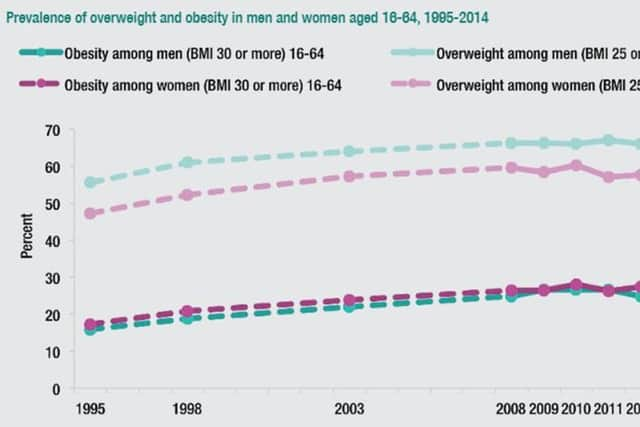Diarmid Campbell-Jack: Scotland’s obesity problem


Using results from the Scottish Health Survey, researchers at ScotCen have been able to look at levels of obesity in Scotland and see how these have changed over the years.
This is a particularly important issue as there are numerous conditions associated with adult obesity such as diabetes, cardiovascular disease, osteoarthritis or cancer and, in the worst cases, adults with high levels of obesity may die. Moreover, we know from other studies that the cost to the NHS in Scotland of overweight and obesity ranges between around £350 to £600 million, mainly due to these various associated conditions.
Advertisement
Hide AdAdvertisement
Hide AdOur findings show that two in every three adults (65 per cent) in Scotland are overweight, with this including 28 per cent who are obese. Interestingly, while a higher proportion of men are overweight including obese than women (69 per cent compared to 61 per cent), a lower proportion were obese (26 per cent compared to 29 per cent).


Looking at figures by age, whereas one in eight (12 per cent) of those aged 16-24 were obese this rose significantly to around one in three (33-36 per cent) of those aged 45-74.
Of course, this rather begs the question of what proportion of men and women in Scotland are actually at a healthy weight?
ScotCen have looked at this in detail, with our analysis showing that there are clear differences by gender, with 29 per cent of men and 37 per cent of women being of a healthy weight last year. In addition, when we looked at different age groups we found that the only age group where a majority of adults were of a healthy weight were those aged 16-24 (57 per cent).
Using historical figures, researchers at ScotCen have been able to track levels of obesity and being overweight right back as far as 1995. What we’re able to show is that while the prevalence of being overweight, including obesity and morbid obesity, in adults rose between 1995 (52 per cent) and 2008 (63 per cent), levels have stabilised since then. A similar pattern was seen both for men and for women, as shown in the following graph.
When we examined in particular the long-term trends just for those who were obese or morbidly obese we again saw a similar pattern of a significant increase from 1995 (17 per cent) and 2008 (26 per cent) followed by a flattening of the trend (27 per cent in 2014).
These figures show a clear and consistent pattern both in terms of how the weight of the country has changed over time and in terms of which groups tend to be affected most. This evidence-base is absolutely vital not only in ensuring that there is a strong evidence-base upon which political decisions can be made but in providing relevant information to ensure each individual can be fully informed on relevant health-related issues.
Diarmid CampbellJack is Research Director at ScotCen Social Research. The Scottish Health Survey interviews around 4,500 adults and 1,500 children each year and is part of the Scottish Government National Statistics.